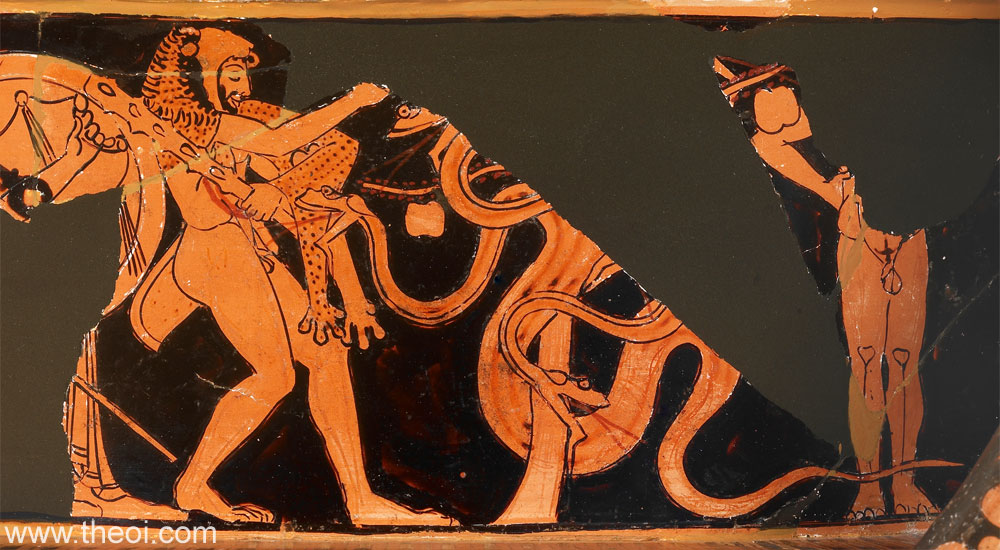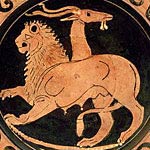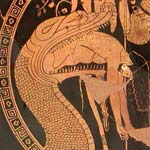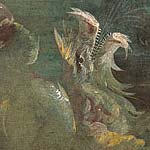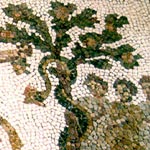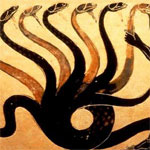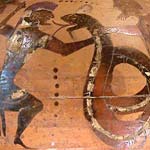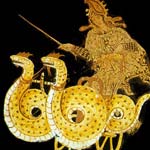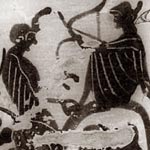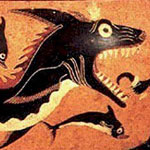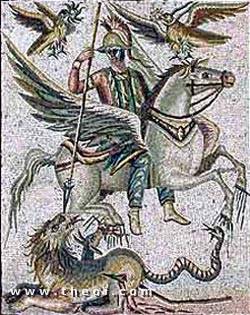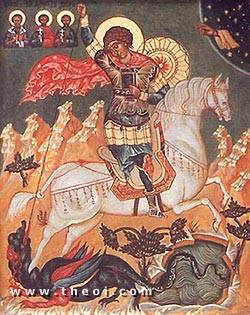DRAGONS
There are four types of dragon in Greek mythology--the serpentine Dracones, the marine Cetea, the fire-breathing Chimaera and the she-monster Dracaenae.
A COMPLETE LIST OF DRAGONS FROM ANCIENT GREEK MYTHOLOGY
The four types of dragon-like creatures known to the Greeks were the Dracones, Cetea, Chimaera and Dracaenae. The first of these occur in both myth and legend--"legend" meaning the ancients believed such creatures inhabited the far corners of the earth in historical times.
I. DRACONES MYTHICAL
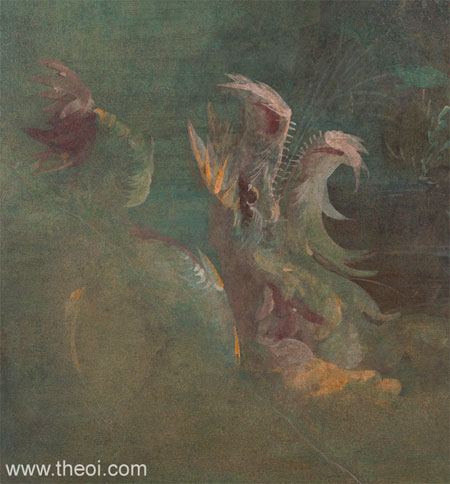
The first type of Greek dragon was the Dracon whose name was derived from the Greek words "drakein" and "derkomai" meaning "to see clearly" or "gaze sharply." It was essentially just a giant serpent which was sometimes equipped with rows of sharp teeth, deadly poison or multiple heads. In myth the beast usually guarded a sacred spring, grove or golden treasure. Our own word "dragon" derives from the creature's name.
COLCHIAN DRACON (Drakon Kholkikos) An unsleeping dragon which guarded the Golden Fleece in the sacred grove of Ares at Colchis. The creature was bewitched by Medea so that the hero Jason could steal its treasure.
CYCHREIDES (Kykhreides) A dragon which terrorized the island of Salamis. It driven out by the hero Cychreus and fled to Eleusis where it became an attendant of the goddess Demeter.
DEMETER'S DRACONES A pair of winged dragons which drew the chariot of goddess Demeter. She gave them to the hero Triptolemos to carry him across the world spreading knowledge of agriculture.
GIGANTOMACHIAN DRACON (Drakon Gigantomakhios) A dragon which was cast at the goddess Athena during the Giant War. She caught it up and threw it into the sky where it formed the constellation Draco.
HESPERIAN DRACON (Drakon Hesperios) A hundred-headed dragon which guarded the golden apples of the Hesperides. It was slain by Heracles when he came to fetch the treasure as one of his Twelve Labors.
HYDRA A nine headed water-dragon which guarded the springs of Lerna. It possessed the power of regeneration, producing two new heads for each that was decapitated. The creature was eventually destroyed by Heracles who cauterized its neck stumps with a flaming torch.
ISMENIAN DRACON (Drakon Ismenios) A dragon which guarded the sacred spring of Ares near Thebes. It was slain by the hero Cadmus who sowed its teeth in the earth to reap a crop of earth-born warriors.
MAEONIAN DRACON (1) (Drakon Maionios) A dragon which ravaged the kingdom of Lydia. It was slain by Heracles when he was in the service of Queen Omphale.
MAEONIAN DRACON (2) (Drakon Maionios) A monstrous dragon which terrorized the kingdom of Lydia. It was slain by the giant Damasen.
MEDEA'S DRACONES Two flying dragons born from the blood of the vanquished Titans. They were yoked to draw the chariot of the witch Medea.
NEMEAN DRACON (Drakon Nemeios) A giant dragon or serpent which guarded the sacred groves of Zeus at Nemea. It was destroyed by the warriors of the Seven Against Thebes after devouring the infant Opheltes, son of a local king.
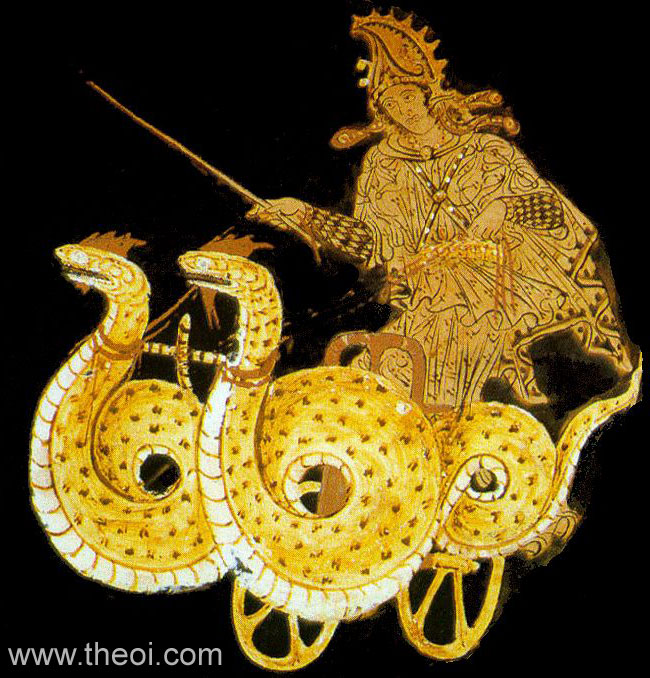
OPHIOGENEAN DRACON (Drakon Ophiogeneikos) A dragon which guarded the sacred grove of the goddess Artemis in Mysia. It mated with the maiden Halia, producing a son named Ophiogeneis, ancestor of the Ophiogenes tribe.
PITANIAN DRACON (Drakon Pitanios) A dragon of Pitane in Aeolia (Asia Minor) which was turned to stone by the gods.
PYTHON A monstrous dragon which was set by Gaea to guard the oracle of Delphi. It was destroyed by the god Apollo when he seized the shrine.
RHODIAN DRACONES (Drakones Rhodioi) Giant serpents and dragons which ravaged the island of Rhodes. They were destroyed by the hero Phorbas.
THESPIAN DRACON (Drakon Thespiakos) A dragon which plagued the Boeotian town of Thespaie. It was slain by the hero Menestratus, who threw himself into the creatures maw wrapped in spiked armour.
TROJAN DRACONES (Drakones Troiades) A pair of dragons sent by the god Poseidon to destroy Laocoon of Troy and his sons when he attempted to warn his people of the threat posed by the Wooden Horse.
II. DRACONES LEGENDARY
The ancients believed the remote, unexplored corners of the earth were inhabited by Dracones. These legendary creatures were similar to their mythical counterparts.
ETHIOPIAN DRACONES (Drakones Aithiopikoi) Giant serpents which inhabited the land of Aethiopia (that is, sub-Saharan Africa).
INDIAN DRACONES (Drakones Indikoi) Dragons found in the hills and mountains of India. They devoured elephants and were destroyed by Indian dragon-slayers with the aid of magic.
PHRYGIAN DRACONES (Drakones Phrygioi) Sixty foot tall dragons found in central Anatolia. They stood upright on their tails in the air, snaring birds with a magical breath.
II. CETEA MYTHICAL
The second type of dragon was the Cetus or "Sea-Monster." The creature usually featured in myths of a sacrificial princess rescued by a hero.
CETEA (Ketea) Gigantic, serpentine sea-dragons.
ETHIOPIAN CETUS (Ketos Aithiopios) A sea-monster sent by Poseidon to ravage the land of the Aethiopians. The king offered ihis daughter Andromeda to it as a sacrifice. But Perseus slew the beast and released the princess from her chains.
TROJAN CETUS (Ketos Troios) A sea-monster which plauged the land of the Trojans. King Laomedon chained his daughter to the rocks as a sacrifice to appease the creature, but she was \rescued by Heracles and the creature slain.
IV. CETEA LEGENDARY
The ancients imagined that Cetea or sea-monsters populated the distant oceans of the world. "Cetus" was also the Greek word for "whale," which was regarded as a type of sea-monster.
INDIAN CETEA (Ketea Indikoi) Fabulous sea-monsters believed to inhabit the Indian Ocean.
SCOLOPENDRA (Skolopendra) A gargantuan sea-monster with hair extending from its nostrils, a flat crayfish-like tail and rows of webbed feet lining each of its flanks.
V. CHIMAERA
The third type of dragon was the Chimera, a fire-breathing monster whose form was a hybrid of lion, serpent and goat. Medieval artists used this creature as the template for the Dragon of Saint George.
CHIMERA (Khimaira) A three headed monster, with the foreparts of a lion, the hind-parts of a goat and goat's-head rising from its back, and the tail of a headed-serpent.
VI. DRACAENAE
The fourth type of dragon was the Dracaena or "She-Dragon," a creature with the upper body of a beautiful nymph and the body of a dracon or sea-monster in place of legs. Two of these creatures, Echidna and Ceto, spawned most of the dragons of myth.
CAMPE (Kampe) A monstrous she-dragon which guarded the prison-gates of Tartarus. She had the body of a serpent, a hundred serpent "feet," and a scorpion's tale. Campe was slain by Zeus when he rescued the Cyclopes and Hecatoncheires from their prison.
CETO (Keto) A monstrous marine goddess with the body of a sea-dragon in place of legs. She spawned Echidna, the Hesperian dragon and other monsters.
ECHIDNA (Ekhidna) The she-dragon wife of the serpent-giantTyphoeus. Echidna spawned most of the dragons and monsters of myth.
ECHIDNA ARGIA (Ekhidna Argia) A she-dragon which ravaged the kgindom of Argos. It was slain by the hundred-eyed giant Argos Panoptes.
POENE (Poine) A she-dragon sent by Apollo to ravage the kingdom of Argos as punishment for the death of his infant son Linos. It was slain by the hero Coraebus.
SCYTHIAN DRACAENA (Drakaina Skythia) The Dracaena queen of Scythia in north-eastern Europe (now, the Ukraine). She stole the cattle of Geryon which Heracles was herding through the region and agreed to return them on condition he mate with her.
SCYLLA (Skylla) A she-dragon which haunted the Straits of Messina, snatching and devouring sailors from passing ships. She was a nymph with the tail of a sea-monster in place of legs.
SYBARIS A she-dragon which haunted a mountain near Delphi devouring shepherds and passing travellers. She was pushed off the cliff by the hero Eurybarus.
EVOLUTIONS - CHIMERA TO SAINT GEORGE'S DRAGON
The Greek Chimaera was a rather un-dragonlike hybrid of lion, goat and serpent. Like later dragons it was described as breathing fire.
Medieval artists used the Greco-Roman image of Bellerophon and the Chimaera as the template for representations of Saint George and the Dragon. The dragon of St George, however, was depicted as an entirely reptilian creature, although its basic posture and shape echoes the form of its classical predecessor.
1. Bellerophon and the Chimaera, Roman mosaic from Palmyra C3rd A.D.
2. Saint George and the Dragon, Medieval painting C14th.
A SELECTION OF QUOTES FROM CLASSICAL LITERATURE
The ancient Greek poet Hesiod in his genealogy of the gods describes how the dragons and monsters of myth were spawned by the immortal Dracaenae Ceto and Echidna.
Hesiod, Theogony 270-333 (trans. Evelyn-White) :
"Ceto bare to Phorcys the fair-cheeked Graeae, sisters grey from their birth: and both deathless gods and men who walk on earth call them Graeae, Pemphredo well-clad, and saffron-robed Enyo, and the Gorgons who dwell beyond glorious Ocean in the frontier land towards Night where are the clear-voiced Hesperides, Sthenno, and Euryale, and Medusa who suffered a woeful fate : she was mortal, but the two were undying and grew not old . . .
And in a hollow cave she bare another monster, irresistible, in no wise like either to mortal men or to the undying gods, even the goddess fierce Echidna who is half a nymph with glancing eyes and fair cheeks, and half again a huge snake, great and awful, with speckled skin, eating raw flesh beneath the secret parts of the holy earth. And there she has a cave deep down under a hollow rock far from the deathless gods and mortal men. There, then, did the gods appoint her a glorious house to dwell in: and she keeps guard in Arima beneath the earth, grim Echidna, a nymph who dies not nor grows old all her days.
Men say that Typhaon the terrible, outrageous and lawless, was joined in love to her, the maid with glancing eyes. So she conceived and brought forth fierce offspring; first she bare Orthus the hound of Geryones, and then again she bare a second, a monster not to be overcome and that may not be described, Cerberus who eats raw flesh, the brazen-voiced hound of Hades, fifty-headed, relentless and strong. And again she bore a third, the evil-minded Hydra of Lerna, whom the goddess, white-armed Hera nourished, being angry beyond measure with the mighty Heracles. And her Heracles, the son of Zeus, of the house of Amphitryon, together with warlike Iolaus, destroyed with the unpitying sword through the plans of Athene the spoil-driver. She was the mother of Chimaera who breathed raging fire, a creature fearful, great, swift-footed and strong, who had three heads, one of a grim-eyed lion; in her hinderpart, a dragon; and in her middle, a goat, breathing forth a fearful blast of blazing fire. Her did Pegasus and noble Bellerophon slay; but Echidna was subject in love to Orthus and brought forth the deadly Sphinx which destroyed the Cadmeans, and the Nemean lion, which Hera, the good wife of Zeus, brought up and made to haunt the hills of Nemea, a plague to men. There he preyed upon the tribes of her own people and had power over Tretus of Nemea and Apesas: yet the strength of stout Heracles overcame him.
And Ceto was joined in love to Phorcys and bare her youngest, the awful snake who guards the apples all of gold in the secret places of the dark earth at its great bounds. This is the offspring of Ceto and Phorcys."
The Greek rhetorician Philostratus speaks of the dragon's love of gold.
Philostratus the Elder, Imagines 2. 17 (trans. Fairbanks) :
"This hill encircled by the sea is the home of a dracon (serpent), guardian doubtless of some rich treasure that lies hidden under the earth. This creature is said to be devoted to gold and whatever golden thing it sees it loves and cherishes; thus the fleece in Colchis and the apples of the Hesperides, since they seemed to be of gold, two dracones (serpents) that never slept guarded and claimed as their own. And the dracon (serpent) of Athena, that even to-day still makes its home on the Acropolis in my opinion has loved the people of the Athenians because of the gold which they make into grasshopper pins for their hair. Here the dracon (serpent) himself is of gold; and the reason he thrusts his head out of the hole is, I think, that he fears for the safety of the treasure hidden below."
The Roman tragedian Seneca catalogues the dragons as he describes the witch Medea calling forth their power with a spell.
Seneca, Medea 684 ff (trans. Miller) :
"Drawn by her magic incantations, the scaly brood leave their lairs and come to her. Here a savage serpent drags its huge length along, darts out its forked tongue, and seeks against whom it is to come death-dealing; hearing her incantation, it stops in amaze, knots its swollen body into writhing folds, and settles them into coils . . . She cries, ‘. . . Hither let that serpent [the constellation Draco] descend which lies like a vast rushing stream, whose huge folds the two beasts [constellations Ursae] feel, the greater and the less (the greater used by Pelasgians; by Sidonians, the less); let Ophiuchus at length relax his choking grip and give the poison vent; in answer to my incantations let Python come, who dared to attack the twin divinities [Apollon and Artemis]. Let Hydra return and every serpent cut off by the hand of Hercules, restoring itself by its own destruction. Thou, too, ever-watchful dragon [of the Golden Fleece], quitting the Colchians, come thou to my aid, thou who through my incantations wast first lulled to slumber.’"
